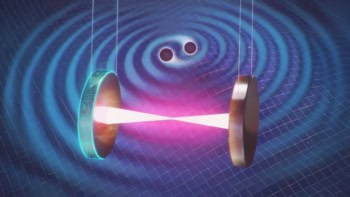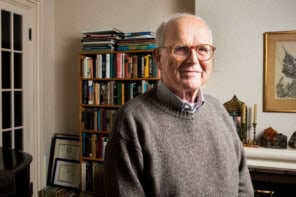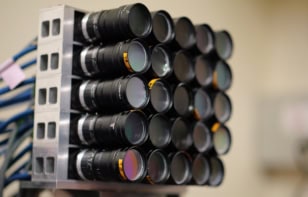Physicists could soon create an artificial black hole in a lab, thanks to Ulf Leonhardt of St Andrews University in the UK. Leonhardt has calculated that a beam of light brought to a standstill in a gas should produce a singularity analogous to the event horizon of a black hole. Pairs of photons emitted from the gas would be similar to Hawking radiation, which is thought to emanate from black holes but has never been observed (U Leonhardt 2001 Nature 415 406).
A black hole is created when a certain kind of star collapses under its own weight. Light becomes trapped inside the perimeter of the black hole – known as the ‘event horizon’ – because the escape velocity needed to overcome gravity at this distance equals the velocity of light. Nothing occurring within the event horizon can be observed from outside.
Physicists have suggested that an analogue of a black hole could be created in the lab by trapping sound or light waves in fluids that are travelling more quickly than the waves. The point at which the fluid speed overtakes the wave speed would be equivalent to the event horizon. But researchers have so far been unable to build such an artificial black hole and measure its quantum properties. In particular, says Leonhardt, schemes so far proposed for optical black holes would be plagued by the Doppler effect that arises from the moving medium. This is a problem because light can only be slowed down in a very narrow frequency range.
Leonhardt has solved this problem by considering a ‘black hole with no moving parts’. A laser beam would manipulate the optical properties of a medium – either an ultracold gas or a crystal – in order to permit the transmission of a second beam of light, known as the probe beam. The probe beam would be directed along the length of the medium, while the first, stronger beam, known as the control beam, would illuminate the length of the sample from above. In this set-up, the group velocity of the probe beam is proportional to the intensity of the control beam. The trick is to calculate the quantum effects of varying the intensity of the control beam parabolically along the length of the medium so that it is a maximum at the ends of the sample and zero at its mid-point.
Leonhardt calculated that such an intensity variation would result in a singularity similar to that associated with black holes. The line perpendicular to the probe beam along which the intensity of the control beam is zero would cut space into two unconnected regions. At this point – as at an event horizon in a black hole – the wavelength of the probe beam would taper to zero.
Pairs of photons that travel away from the singularity in opposite directions would also be created, resembling the pairs of particles and anti-particles predicted to occur near the event horizon of a black hole. One particle in each pair should fall into the black hole while the other escapes as so-called Hawking radiation. Astrophysicists have yet to detect any such particles because they are obscured by the ubiquitous cosmic microwave background. But being able to study their analogues in the lab would help physicists to bridge the gap between quantum mechanics, which dictates pair production, and general relativity, which governs the behaviour of black holes.
Leonhardt describes his set up as a ‘naked horizon without the catastrophic attractive force of a black hole’. He adds that there would be ‘absolutely no danger at all’ if such an experiment were built.



